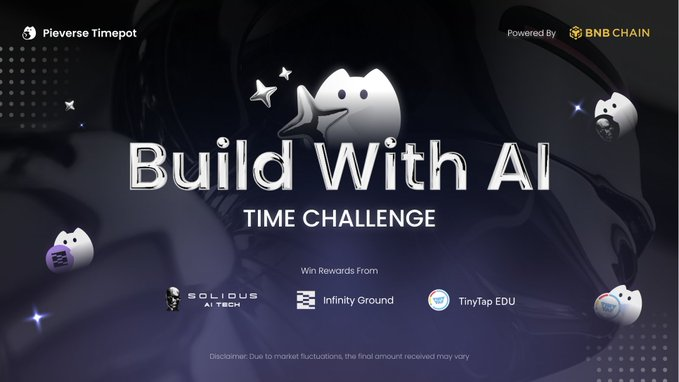
Pieverse operationalizes the idea of “time = asset.” It packages an intelligent AI calendar and TimeFi tools into a collaboration assistant (AI Co-Pilot), so users can plan schedules, set verifiable time challenges, and map social commitments and personal goals into on-chain incentives and constraints—all in one interface. The website and ecosystem pages show that Pieverse’s TimeFi components cover Time Challenges, Time Bids, Funds, and Tasks, offering “programmable time finance” for productivity and social scenarios.
This Innovation and Tech article analyzes Pieverse from positioning, technical architecture, tokenomics, ecosystem & progress, to roadmap and risks.
Summary: By combining an “AI calendar + TimeFi protocol,” Pieverse connects planning, execution, and outcomes on-chain: set challenges or tasks → stake/reward → settle by proof. It emphasizes efficiency while providing auditable incentives, serving individuals and team collaboration.
Positioning: What Problem Is Pieverse Solving?
In traditional productivity tools, planning and incentives have long been decoupled: completion is hard to quantify and settle, and collaboration relies on offline trust. Pieverse positions itself as a “time-economics Co-Pilot,” orchestrating Plan → Do → Settle in one protocol: users create “time challenges/tasks” in the AI calendar, collateralize with on-chain funds or rights, and settle rewards or slashing automatically based on proofs of completion—creating a sustainable collaboration model of “positive feedback + constraints.” Its TimeFi design explicitly lists four primitives—challenges, bids, funds, and tasks—providing modular building blocks for personal goals, team sprints, and creator activities.
Technical Architecture: AI Calendar Engine × TimeFi Primitives × Settlement & Audit
AI Calendar Engine: From Text to Executable Plans
The AI Co-Pilot reads calendars, messages, and to-dos, extracting goals, milestones, and dependencies; it automatically matches TimeFi components (e.g., mapping “run 3 times a week” to a “weekly Time Challenge”) and suggests budgets and incentives. For individuals, the focus is turning “fuzzy intent” into “verifiable tasks”; for teams, the emphasis is on multi-person coordination and aligning roles and time.
TimeFi Primitives: Challenges, Bids, Funds, and Tasks
- Time Challenges: create deadlines and thresholds around a goal, set collateral/pools, and allocate returns or penalties by attainment (explicitly listed on the site).
- Time Bids: participants bid on others’ time commitments, forming a crowdsourced, results-oriented market.
- Funds & Tasks: finance high-value goals or public outcomes via funds or task pools, with settlement and retrospection recorded on-chain.
Settlement & Audit: Verifiable Proofs of Completion
Proofs can be multi-source: app events, device data, or witness signatures. Once conditions are met, contracts auto-execute rewards/slashing and record them on-chain. BNB Chain’s dApp directory summarizes Pieverse’s positioning of “financializing social behavior, productivity, and interaction,” which implies auditing across the full path of “goal — proof — distribution.”
Tokenomics (Tentative): Supply, Allocation, and Utility
As of writing, Pieverse has not disclosed full token details in a public white paper; ecosystem/info channels feature previews and resource indexes, but total supply, allocation, and emission curves are subject to the final official documents. To aid evaluation, we outline a common, auditable design framework and cite standard industry practice.
Quantity & Emissions
- Total and initial float: set a cap and initial circulation to avoid over-issuance.
- Vesting curve: team/advisors commonly use “cliff + linear”; ecosystem/rewards are behavior-based with caps and decays.
- Transparent dashboards: provide on-chain verifiable vesting/unlock dashboards, disclosing TGE and pool progress.
The above interprets general industry norms, not Pieverse’s final parameters.
Allocation
- Ecosystem & community: incentivize TimeFi usage (challenge creation, verification, task completion).
- Treasury & partnerships: fund ecosystem integrations and public goods.
- Team & advisors: bind to product milestones to mitigate short-term sell pressure.
- Early/Public: bring in long-horizon participants with clear unlock paths.
Utility
- Fees & discounts: fees for challenge/bid creation, audit exports, and template marketplace.
- Staking & reputation: organizations or witnesses stake for higher limits and revenue shares, with slashing for errors/malice.
- Governance: on-chain voting for parameters (e.g., slashing ratios, proof thresholds) and treasury usage.
Until formal tokenomics are released, evaluation should focus on usage intensity (TimeFi DAU/settlements) and real fees (cash flows from creation/settlement/audit), rather than secondary price.

Ecosystem & Partnerships: From Productivity to Community Economies
RootData shows Pieverse running activities and partnerships around the “time economy,” attracting creators and teams with easy-to-use modules—challenges/tasks/bids. Third-party databases tag it as DeFi × Social Token and mention “collaboration boards for VC scenarios,” indicating that “time finance” addresses not only personal goals but also organizational needs such as project collaboration and community voting.
Who Will Use Pieverse
Individuals & creators: turn fitness, learning, and content output into “incentivized plans,” avoiding unfulfilled pledges.
Teams & DAOs: govern time investment via tasks and funds, binding delivery to distribution.
Education & public-interest orgs: convert volunteering and milestones into auditable tasks to strengthen transparency and sustained participation.
Recent Progress & External Signals
The official site continues to update “TimeFi components” and entry points; social channels highlight deployments around BNB Chain (primitives such as challenges/tasks/funds). The BNB Chain dApp directory provides a summary page to track product updates and ecosystem tags. For research, use the website and ecosystem directory as primary sources, and observe actual usage via activities/challenges announced on official channels.
Roadmap
Refine the AI Co-Pilot’s “plan → challenge” mapping and multi-source proof ingestion; open template libraries and audit exports to lower creation and retrospection costs; extend organizational/team permissions and roles; launch advanced governance parameters and dashboards for “time funds/bids.” Accrue “time credit” as a cross-app, reusable reputation asset; explore multi-chain interoperability and privacy-preserving computation to cover broader workplace, education, and creator-economy scenarios.
FAQ
How is Pieverse different from a normal calendar/to-do?
It connects plan—execution—settlement end to end: TimeFi primitives bind commitments to incentives and form auditable on-chain records.
What TimeFi components are built-in?
The site lists Time Challenges / Time Bids / Funds / Tasks, covering personal goals, collaborative bidding, and public funding.
Is Pieverse listed by third parties?
The BNB Chain dApp directory provides a product summary and tags, serving as one tracking entry.
When will token allocation be announced?
Refer to the official white paper; research should focus on real usage and fees, not just secondary-price expectations.
Key Takeaways
Positioning: Pieverse is an AI Co-Pilot for time-economics scenarios, turning commitments into verifiable incentives via TimeFi.
Technology: AI calendar engine × TimeFi primitives × settlement & audit build a closed loop of “plan—act—settle.”
Economy: token details pending; evaluation should focus on real usage and fees; adopt transparent emissions and dashboards per industry norms.
Ecosystem: third-party databases and on-chain directories have listed it; track challenge/task activity and completion to judge network effects.




